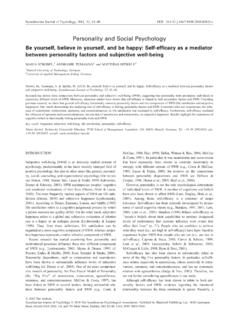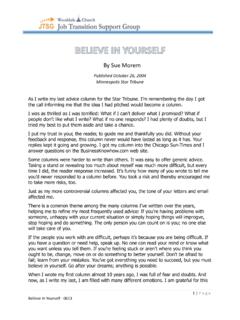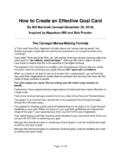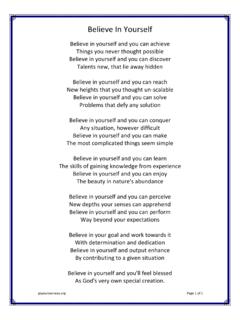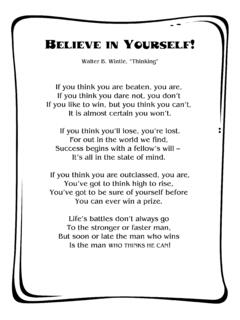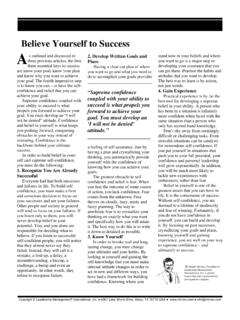Transcription of Believe in yourself: Manipulating beliefs about memory ...
1 memory Confidence 1 Running head: memory CONFIDENCE Believe in yourself : Manipulating beliefs about memory causes checking Gillian M. Alcolado* and Adam S. Radomsky Department of Psychology, Concordia University, Canada *Corresponding author address: Concordia University Department of Psychology, 7141 Sherbrooke St. West, Montreal, QC, H4B 1R6. memory Confidence 2 Abstract One of the most common compulsions in obsessive-compulsive disorder (OCD) is repeated checking. Although individuals often report that they check to become more certain, checking has been shown to have the opposite effect - increased checking causes increased uncertainty.
2 However, checking may also be thought of as beginning because of memory uncertainty. beliefs about responsibility, over-estimation of threat, intolerance of uncertainty, perfectionism, and importance of and control of thoughts are already known to affect different aspects of OCD symptomatology. beliefs about memory , however, are not currently considered to influence compulsive behaviour. In the current study, beliefs about memory were manipulated to test whether or not they affected urges to check. Ninety-one undergraduate participants received (positive or negative) false feedback about their performance on aspects of a standardized memory test, and then completed two additional memory tasks.
3 Their urges to check following these tasks were assessed. Consistent with our hypotheses, individuals in the low memory confidence condition had greater urges to check following the memory tasks than those in the high memory confidence condition, demonstrating that manipulations of beliefs about memory can influence checking. Results and implications are discussed in terms of cognitive-behavioural models of and treatments for OCD. Keywords: OCD; checking; beliefs ; memory ; confidence; Confidence 3 Believe in yourself : Manipulating beliefs about memory causes checking Obsessive-compulsive disorder (OCD) is a an anxiety disorder (American Psychiatric Association, 2000), affecting approximately of the population (Stein et al.)
4 , 1997). The disorder is characterized by obsessions ( , repetative intrustive thoughts, images, impulses) and/or compulsions ( , repeated behaviour designed to decrease/prevent negative thoughts/events; American Psychatric Association, 2000). Two of the most frequently reported compulsions in OCD are those related to repeated checking or washing behaviours, with approximately seventy-five percent of the OCD population reporting engaging in either or both types of rituals (Ball, Baer, & Otto, 1996). The aim of the current experiment was to examine whether Manipulating beliefs about memory could affect urges to check, as a clearer understanding of the cognitive mechanisms underlying this aspect of the disorder could improve treatment and quality of life for individuals with OCD.
5 OCD was historically difficult to treat, until exposure and response prevention (ERP) became the first successful psychological intervention for the disorder (Meyer, 1966; for a reveiw, see Abramowitz, 2006) . Developed from learning principles and animal research, ERP required clients to expose themselves to their feared obsessions ( , by turning off a stove) without allowing them to engage in compulsive or neutralizing behaviour ( , by not checking that it was actually off), and to observe the eventual decrease of their anxiety and fear (see Marks, 1973, for an overview).
6 Although this treatment has been found to be equally as effective as pharmacotherapy, it still leaves a number of people unwell ( , Foa et al., 2005). Salkovskis (1985) posited that the manner in which people respond to stimuli associated with OCD is based on their elevated beliefs about their personal responsibility towards preventing harm to themselves and others. This theory has been well supported by empirical memory Confidence 4research ( , Lopatka & Rachman, 1995; Arntz, Voncken, & Goosen, 2007). For example, Lopatka and Rachman (1995) manipulated participants responsibility beliefs in different situations and found that those who felt responsible had greater urges to check items they typically verified than those who did not, despite the fact that they were all diagnosed with OCD.
7 This demonstrated that beliefs about responsibility play an important role in checking behaviour. Later, the Obsessive Compulsive Cognitions Working Group (OCCWG) identified three groups of belief domains related to OCD and its differential diagnosis, and created a unified tool to assess them (OCCWG, 2005). These were responsibility and over-estimation of threat, intolerance of uncertainty and perfectionism, and importance of and control of thoughts (OCCWG, 2005). Targetting these maladaptive cognitions in treatment was an obvious progression. Research shows that cognitive-behavioural therapy (CBT) for OCD changes beliefs and that this cognitive change is responsible for symptom reduction ( , O Connor et al.)
8 , 2005; although there is still some debate about this, see Clark, 2005). An open trial of a manualized form of cognitive therapy for OCD has proven to be effective at treating the symptoms of the disorder, the beliefs associated with disorder, and co-occurring depression and anxiety (Wilhelm et al., 2005). Impressively, a portion of these individuals had previously failed to benefit from ERP but improved following cognitive therapy (CT), implying that targeting maladaptive beliefs in therapy may be sufficient for improvement (Wilhelm et al., 2005).
9 CBT has also been shown to be comparable in effectiveness to that of ERP (Whittal, Thordardson, & McLean, 2005). More recently, a randomized controlled trial of CT for obsessions showed that compared to stress management and waitlist control groups, the CT group improved significantly more on measures of OC beliefs , and had an advantage at post-treatment (Whittal et al., 2010). memory Confidence 5As such, it may be that a broader cognitive understanding of OCD may contribute to more eficacious treatments of the disorder. Rachman (2002) proposed a cognitive theory of compulsive checking which postulated that people will check under circumstances in which they feel they have an elevated sense of responsibility for preventing serious harm, especially when they feel they cannot be sure that the threat has been removed.
10 He further hypothesized that checking becomes more severe with the increase of three cognitive multipliers: (1) the perceived probability of harm occurring, (2) the perceived seriousness of harm, and (3) the perceived responsibility for preventing harm. Interestingly, he posited that when one feels more responsible for the outcome of an event, one also believes that the likelihood of it happening has increased. Rachman also suggested a number of elements that help maintain checking behaviour once it has begun. One repeatedly checks in a futile search for a certain end to the harm (which does not exist).




